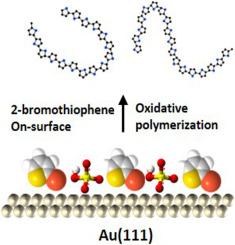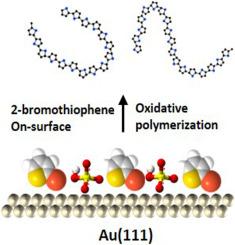Anion-modulated self-assembly and on-surface polymerization of 2-Bromothiophene on Au(111)
IF 5.6
3区 材料科学
Q1 ELECTROCHEMISTRY
引用次数: 0
Abstract
We report the anion-modulated self-assembly and electrochemical polymerization of 2-bromothiophene (BrT) on Au(111), probed by cyclic voltammetry and in situ scanning tunneling microscopy (STM). BrT forms ordered adlayers with distinct unit cells—(3 × 3), (3 × 2√3), (4 × √31), and (√7 × √13)—whose packing density depends on the applied potential and electrolyte anion. In H₂SO₄, bisulfate coadsorption stabilizes open, dynamic BrT structures, whereas in HClO₄, weak perchlorate adsorption enables compact packing at higher potentials. At anodic bias (≥ 0.9 V verse Ag/AgCl), BrT undergoes irreversible oxidative coupling, yielding surface-bound oligothiophenes aligned with Au(111) crystallography. The dual S/Br anchoring of BrT ensures stable adsorption, preferential alignment, and robust film growth. These results reveal a critical role of anion–molecule interactions in directing surface assembly and demonstrate a tunable pathway for potential-controlled nanostructure fabrication.


阴离子调控的2-溴噻吩在金上的自组装和表面聚合(111)
利用循环伏安法和原位扫描隧道显微镜(STM)研究了2-溴噻吩(BrT)在Au(111)上阴离子调制的自组装和电化学聚合。BrT形成具有不同单位细胞的有序层-(3 × 3),(3 × 2√3),(4 × √31)和(√7 × √13)-其堆积密度取决于应用电位和电解质阴离子。在H₂SO₄中,硫酸氢盐的共吸附稳定了开放的、动态的BrT结构,而在HClO₄中,弱高氯酸盐的吸附使高电位下的致密堆积成为可能。在阳极偏压下(≥0.9 V vs Ag/AgCl), BrT发生不可逆的氧化偶联,生成具有Au(111)晶体结构的表面结合寡硫吩。双S/Br锚定的BrT确保稳定的吸附,优先排列,和稳健的膜生长。这些结果揭示了阴离子-分子相互作用在指导表面组装中的关键作用,并展示了一种可调的电位控制纳米结构制造途径。
本文章由计算机程序翻译,如有差异,请以英文原文为准。
求助全文
约1分钟内获得全文
求助全文
来源期刊

Electrochimica Acta
工程技术-电化学
CiteScore
11.30
自引率
6.10%
发文量
1634
审稿时长
41 days
期刊介绍:
Electrochimica Acta is an international journal. It is intended for the publication of both original work and reviews in the field of electrochemistry. Electrochemistry should be interpreted to mean any of the research fields covered by the Divisions of the International Society of Electrochemistry listed below, as well as emerging scientific domains covered by ISE New Topics Committee.
 求助内容:
求助内容: 应助结果提醒方式:
应助结果提醒方式:


